
THE NAVAYATHS OF BHATKAL
The mention of the name Bhatkal will invariably conjure before anyone the image of Navayaths. Yes, Navayaths are a decisive force in Bhatkal. As is natural in the case of all human beings, the Navayaths also have made a relentless search for their roots and have come up with a plausible answer They are a small yet significant sect among the Muslims and are living mainly in and around Bhatkal. They have traced ancestry to the Arabs,the traders of the medieval.
Settlements of Navayathis
Their old settlements comprise clusters of old structures in compact areas and are called Saiys. Houses are seen constructed wall to wall on either side of the street. In every street. there is a mosque catering to the spiritual needs of the devout inhabitants. The new settlement consist of beautifully designed sprawling mansions with all amenities usually available in megacities.
Mode of Life
The traditional code of dress of Navayath men consists of kurta, lungi and topi. Their ladies have opted for the local Indian way of dressing. Not withstanding this, full purdah is a must for women. The Navayaths are generally light skinned and good looking. They are very religious-minded. The 38 mosques of Bhatkal bear eloquent testimony to their piety and so do the numerous religious schools established in this town. This is further substantiated by the fact that there is quite a large number of young Hafiz who have committed the entire Holy Quran to memory. Quite many of them belong to the age group 12-15. Jamia Islamia, the premier and prestigious college for Islamic learning for boys attracts students from far and wide. Similarly Jamiatus-Salihat is an institution meant for girls.
Social Customs
Navayaths of Bhatkal do not go in for intercaste marriages. There may be exceptions, but exceptions, it is said, only prove the rule. Marriages are conducted as laid down in the laws of Islam. It is gratifying to note that the obnoxious and much-hated dowry system has not raised its dirty head in the Navayath community and has been strictly prohibited. Wherever the Navayaths go, they settle in groups and make it point to live in close contacts with the other religious life. An intense fraternal feeling prevails amidst all Navayaths. They belong to the Shafi school of thought. Paradoxical though it may seem, the affluent Navayaths remained educationally backward for a deplorably long spell. The Anjuman-Hami -e- Muslimeen spear-headed the long drawn battle against illiteracy. A wide range of educational institutions ranging from the kindergarten schools to the professional college have come into being. At last these efforts have begun to pay dividends. Scores of Navayaths have emerged as engineers and doctors. Three periodicals are brought out by the Navayaths. One in English-"The Bhatkal Times' which began its innings from August 1990. This fortnightly news magazine is edited by Aftab Hussein Kola. The script is called Navayathi. Another two periodicals called the 'Naksh-e-Navayath and Al Ittihad’ (forthnightlies) as been in this field .The Navayath community can pride over the fact that it has produced quite a good number of distinguished sons of India who by their magnanimity and service-mindedness, raised the image of India notch by notch. While late I.H. Siddique was a top-ranking freedom fighter and a legislature of Bombay Assembly, M.M. Siddique was a social worker and front-line crusade who waged a relentless war against the many ills plaguing the society at large. A.K. Hafizka served India as her ambassador to Saudi Arabia in 1977. As the member of the Legislative Assembly of Bombay and BPCC (I) president he served the state to such an extent that he became the pride and envy of his counterparts. J.H.Shamsuddin rose to the position of a deputy minister for electricity and finance in the early sixties. The contemporary Navayath community too has not lagged behind in this respect. It has many outstanding personalities on various fronts. Thus, S.M. Yahya who has served the Govt. of Karnataka in various capacities as the Finance Minister, Minister of Industries and the Education Minister and is presently an M.L.A. and the senior vice president of KPCC(I) is a Navayth. Navayths show great affinity towards Urdu poetry and the community has produced eminent poets like Dr.Muhammad Husain Fitrath , Mr. Payam Sayeedi, Mr. Hasrat Bhatkali, Syed Abubaker Maliki, Mohd Hasan Muallim, Mohd Ali Qamar, and Abdul Rahim Irshad who have acquired national fame. Majlis-e-Islah-o-Tanzeem, the official organ of the Navayaths, is making strides in the social and political fields. It is regarded as the most powerful Muslim organization in the entire Uttara Kannada district. If any single community can claim the credit for projecting Bhatkal on the map of India, it is the Navayaths. They have toiled untiringly to make Bhatkal a healthy and happy place to live in and have accelerated the developmental process of this palm tree-studded silvery shore. To put it in a nut-shell, it would suffice to say that they can look back to an excellent track record and look forward to a still more promising future.
GREAT SOULS OF BHATKAL
The soil of Bhatkal has given birth to some illustrious men whose work will never die. We are giving below the thumb-nail sketches of such great souls who thought more of the society around them than they did about themselves. They were very much concerned about the well being of the society. We took the arduous task of compiling pen sketches about them. But we were confronted with certain difficulties when we made an attempt to select a lot of all-time great's from the galaxy of great and self-less personalities.Our intention in presenting them is that the foot prints they have left in the sands of time should be our lodestar and that starting from where they left their lives and taking a leaf or two out of their books we should carry the torch still further.
Akrami, Moulana Khawaja Bahauddin
Moulana Khawaja Bahauddin Akrami was yet another proud son of Bhatkal who made valuable contributions to the progress of Navayath community.Moulana completed his primary education at Vellore in 1919. Being a pious and godly man. he went to Nadwa in the 30's and took up religious studies. He was a prolific writer in Urdu & Navayath languages. He served as the editor of an Urdu periodical `Hindustani'. Subsequently Moulana Khwaja started publishing the `Al-Navayath' in 1930. Unfortunately this venture died a premature death. He authored two books, 'Arab-o-dayare-hind' and 'Tazkir-e-Anjuman'. The Moulana was awarded the state literary award for his Arab - o - dayare-hind' book.
Akrami, Sharief Mohiddin Moulana
Sharief Mohiddin Akrami was the worthy son of the worthy father Kaazi Mohammed Amin Akrami. He had his primary education in Darul-Deoband. In fact he was one of the first three Bhatkalies who had the great good fortune of going to Deoband for education. Further he continued his studies in Farangi Mahal where he had the opportunity of learning under great and eminent teacher like Abdul Bari Farangi Mahali who was a living legend. On conclusion of his studies, Sharief Mohiddin Akrami joined Islamia Anglo Urdu High School as a teacher of religious and moral education (Deeniyat). He was made an Assistant Kaazi of Bombay.Damda Abdul Kadir
Successful businessmen are not that rare. Nor are scholars. But individuals in whom we come across a combination of business acumen coupled with erudition are indeed rare. And Abu Abdul Kadir Bapu - fondly called Abu Moulvi-belongs to that rare breed.Abu Abdul Kadir Bapu was born in 1870. In some respects he was a chip of the old block. His father was a business tycoon owning a network of establishments at far flung places like Calicut and Bellary.Damudi, Abu Abdul Rahman
from the fringe to the centre stage-this sums up the story of Abu Abdurrahman Damudi's life.Born in a poor but very respectable family Abu Abdurrahman Damudi, as could be expected, had to ontinue his education at the end of the primary stage. However, lack of higher education did not stand in the way of his endeavor to expand the horizon of his knowledge. He was a voracious reader prompted by an insatiable thirst for knowledge. His interest in religious books was especially phenomenal. Another striking feature of his personality was that he was one among the very few people who knew the Persian language.Damda Abu, Mohammed Amin Chadu
D.A. Mohammed Amin Chadu-Chadubhao to all his friends was born in1905. From a very young age he dedicated his time and energy to social service. First as the secretary and then as its president Mohammed Amin rendered valuable service to Jamathul muslimeen. Further he took anFaqui Ahmeda, Mohammed Hasan
The community owes a deep debt of gratitude to F.A. Mohammed Hasan who made outstanding contributions to the establishment and development of Anjuman Hami-e- Muslimeen.F.A.Mohammed Hasan was born in 1898 and after passing the matriculation examination did his F.A. in Coorg. At a time when educational institutions were few and far between this was no ordinary achievement. Like every other man of vision, F.A. Mohammed Hasan too realized the importance of providing educational facilities to the people of Bhatkal. He subscribed to the view that education held the key to all future development. Unfortunately F.A.Mohammed Hasan died in 1920 at a tender age of 23. With this Bhatkal lost a promising and dynamic leader who could have opened a new chapter in its chequered history. But alas! It was not to be so.Kola, Abdurrahman
Endowed by Mother Nature with a photographic memory and propelled by an insatiable thirst for knowledge, Kola Abdurrahman pushed the frontiers of his knowledge by the hour and came to be recognised as a prodigy. Born in 1906, Mr. Rahman, after his formal education in Colombo established a flourishing textile business there. His enterprising nature prompted him to expand his business to Pakistan and to several places in India. Try however he might Abdurrahman could never be away from his native place for long. Nostalgia attracted this great man to Bhatkal. As he was a man of impeccable credentials people held his opinions in high esteem.Vaman Narasimha Nayak
Late Vaman Narsimha Nayak was born in an affluent Nayak family of Bhatkal which is held in esteem to this day. After passing the mulky examination (the present VII standard) he inherited his father's mantle and became businessman.That was the time when the level of literacy was pitiably low in the North Kanara District. Still the British did precious little to improve the situation. The farsighted leaders of Bhatkal were very much concerned about this sorrowful state of affairs. In addition to being the biggest wholesale merchant in Bhatkal Vaman Nayak was also an industrialist owning rice and oil mills. Vaman Nayak died when he was 75.Shrinivas Hanumanth Pai
Late Shrinivas Hanumanth Pai helped the cause of communal harmony by serving as the liaison officer between the Navayths and Hindus at Bhatkal. The Navayaths held him in high esteem. It was through their unstinting support the he became the president of Bhatkal Town Municipal Council when the muslim councillors out numbered their Hindu counterparts.Besides being one of the founder member of Bhatkal Urban Co-operative Bank, he served this institution as its Vice-president. Further more, he was the founder trustee of Sri Shanteri Kamakshi Temple Srinivas Pai expired in 1980 at the age of 61.D.L. Keshni
Devaiya Lachmaiya Keshni hailed from a middle class agriculturists family of Mundalli in Bhatkal Taluk. The whole taluk was backward in all respects. Keshni's father had to struggle hard to make both ends meet.Keshni managed to study upto the metric examination. He joined the revenue department and retired as a sub-registrar. He was the president of the taluk Development Board, Bhatkal for two successive terms. He was one among the founders of Namadhari Samaj Sangh and served the association as the president for many years.MOSQUES IN BHATKAL
We have seen thee (O Prophet) often turn thy face towards heaven (for guidance) and now we shall indeed make thee turn in prayer in direction which will fulfill thy desire. Turn then, thy face towards the Inviolable House of Worship; and wherever you all may be, turn your faces towards it (it Prayer)!-an interpretation of Ayat No. 144 of Al-Baqarah from the Holy Qur'an.Perhaps no other religion in the world has given so much importance to prayer as Islam has. Prayer is indeed one of the pillars of Islam. And that is how mosques have come to occupy the pride of place in the life of Muslims and that is why the Muslim hold the mosque dear and near to their hearts.Bhatkal greets you with the stately minerets. The crescendo of the muezzin's call for prayer reverberates from above the roof-tops of the town and waves of the sea carry it far and wide with 38 mosques Bhatkal enjoys the distinction of being the town of mosques. Eight mosques, except one, which belong to earlier period have been demolished and built anew. These ones now renovated, were rectangular building with pyramid-shaped tiled roofs having an outer hall and an inner room. The new ones are built in modern styles. Given below is thumb-nail sketch of the different mosques of Bhatkal with their wide variety of architectural style and designs.
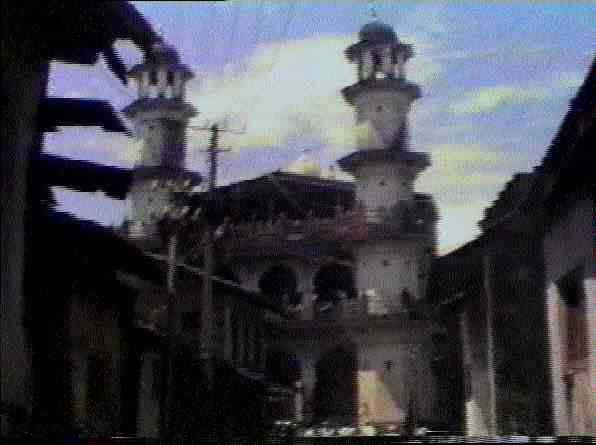
Jamia Masjid
By far the biggest mosque in the town, the Jamia Masjid symbolized the culture of the people of Bhatkal. Located amidst old houses on the Jamia Street, this giant imposing mosque has been renovated from the older one.The older one too had undergone two renovations. the earlier mosque, known as Jamia Masjid Qadeem is believed to have been built in 1447 A.D. an inscription in Persian dated 851 Hijri (or 1447 A.D.) found on a marble slab is still preserved. Because of its gold-plated dome the Masjid is locally called the `Chinnadapalli' (Golden mosque). The present Masjid can accommodate about 5,000 namazis at a time.
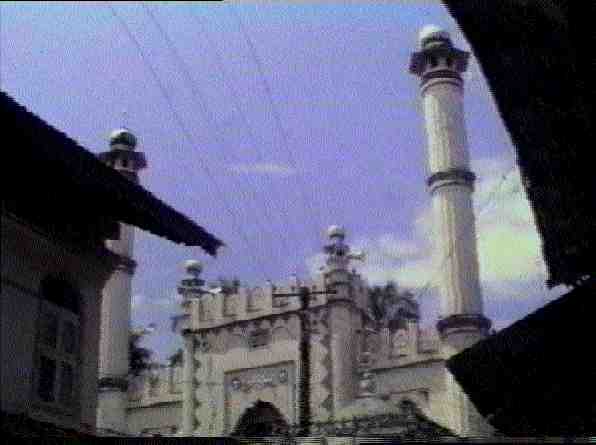
Khalifa Jamia Masjid
The big Masjid belongs to the old category of mosques, which are eight in number. No date of its construction is available, but it is more than 200 years old. Lying on the bank of Sharabi river at the corner of Kalifa street, this Masjid was completely demolished in 1966 and the new structure with two high rising minarets was completed in 1972.
Sultan Masjid
Sultan Mosque is the most famous one in Bhatkal and attracts the highest number of namazis at a given time. Built by Tippu Sultan in the year 1211 HI, this Dravidian style structure became the pride and envy of all the mosques.
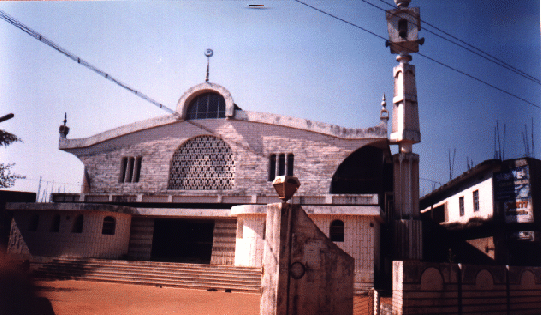
Noor Masjid
One of Karnataka's finest mosques, the Noor Mosque stands imposingly with all its might on the National Highway at the heart of the town. The heart of the town. The old Noor Masjid , built in 1966 was demolished and this new modern Masjid was inaugurated in 1987. About 1,500 Muslims, at a time, will be able to pray in this elegant Masjid.
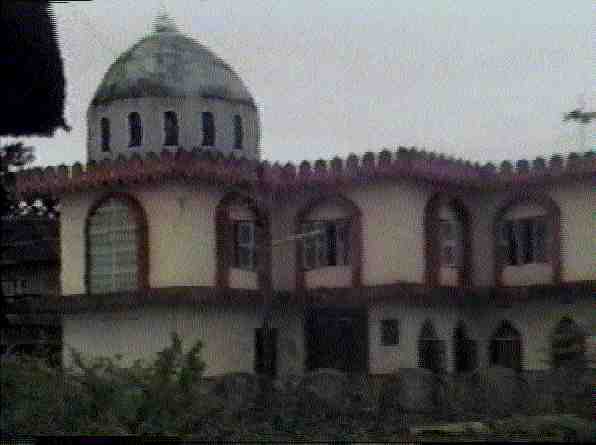
Makhdoom Masjid
The Masjid takes the name of the place `Makhdoom Colony' in which it is located. This place, i.e., Makhdoom colony, derives its name from Hazrath Makhdoom Faqui Ismail Sukri who once sat near here for the worship of Allah for forty consecutive days, called as Chilla.
Masjid-E-Syedna Ismail
This mosque is located in locality comprising both Muslims and Hindus. Built in 1987, the Musjid-e-Syedna Ismail derives its name from a Muslim Religious scholar.Tanzeem Jamia Masjid Situated on Tanzeem Road in Navayat Colony, the Tanzeem Jamia Masjid was built in the year 1963. And now, Tanzeem mosque has been further extended to provide more space. It has capacity to house a congregation of about 3000 people. It serves as the centre of Muslims in the Navayath Colony area.
Makka Masjid
Located on the outskirts of Bhatkal off the National Highway towards Shirali and adjacent to an iceplant, the Makka Masjid was constructed in 1984.Sayyedina Usman Masjid
Deriving its name from Syed Usman, a Khalifa, the Syeddina Usman Masjid is located in Navayat Colony constructed in April 1983.Masjid-Ul-Eman
Iman means faith. The Masjid-Ul-Eman, built in 1989 and having a compound area of 21/2 guntas is situated in the Nagoya Naik Road.Mushma Masjid
It is believed that this was previously called Mohteshima Masjid because Mohtesham family members were maintaining the mosque. And this has subsequently changed into Mushma in colloquial language. The Mushma Masjid is located in Mushma Street. One of the oldest mosques and is known to be in existence about 200 years back, this is the only mosque which is preserved intact.Masjid-E-Hilal
This Masjid was inaugurated immediately after sighting the moon which marked the beginning of Ramadhan and so the Masjid was named as `Masjid-e-Hilal'. This mosque built in 1978 is located in the Hilal street of Makdoom Colony.Gar-E-Hira Masjid
The Gar-E-Hira Masjid is the name of a cave in the desert of Arabia where Prophet Muhammad used to worship Allah.Masjid-E-Syedna Khalid Bin Waleed
Consecrated in may 1985, this spherical mosque is named after a famed Muslim historian Sydena Khalid. The round dome makes up the entire structure with a high elegant minaret on one of its corners.Masjid-E-Ikhwan
Built in the year 1983, the Masjid-e-Ikhwan is on the Basti Road.TEMPLES IN BHATKAL

The Hindu philosophy accommodates diverse interpretations of
its ancient scriptures. It stands for a process of evolution extending from
the worship of arthromorphic God, to the realisation of self as God. A Hindu
temple symbolises this process. The styles of temple have reflected their basic
purpose and the different views of the civilisation in which they occur. Bhatkal
town is not only famous for elegant mosques, but also for the temples that dot the
town. The old structures have withstood the ravages of time to tell the tales of the
past splendour. And there are new ones built by the new generation people. While the majority of
the ancient temples are situated in Mudbhatkal, lying to the east of the town, the
new ones and a few older structures are in the town. The temples dotting
Mudbhatkal include Khetapayya Narayana, Joshi Shankarnarayana and Choleshwara. Other temples in the area are as follows:
Santappa Nayaka Tirumala temple was
constructed by Santappa Nayaka, who is believed to have been the brother-in-law of
Khet Pai. In this temple, God Venkataramana is worshipped. Built in 1555,
profusely sculptured motifs adorn the walls.
The Virupaksha Narayan temple
is a small structure built in 1565 by Jeevana Nayaka. The Narasimha temple is
another fine structure in Mudbhatkal. A hero stone is found on its left corner. Nothing is visible on it. A merchant by name Narasa Kini
built the temple in 1538. The ceiling is adorned with fine images of Brahma and
its Navaranga has pillars with lathe-turned top. Lakkarasa Kamthi Lakshmi
Narayana is a small monument in the green field. The temple is assigned to 1550
AD. The Raghunath temple in the area is assigned to 1590 AD and was built by
Bala Kini Bhatkal town proper, too, has a score of temples including a few
older ones. The cynosure of all is the Maruthi temple at car Street. During
its construction period, which we couldn't trace out, eight guardian angels
called `Astadik- palakaru' were installed in its eight directions with a belief that
these will guard the temple from unforeseen evils. The Maruthi is the gramadevata of
Bhatkal. During March-April, a car festival of this temple is held. The Shri
Marikamba temple, renovated in 1980, situated on the busy main road
(Marikatta) The Nichchalamakki Sri Venkatar -amana temple at Asarkeri is
another famous temple here which has about 200 years history. His Holiness Sri Ramanujacharaya and Sri Madhavacharya installed Sri venkata-
raman idol, which was brought from Tirupathi. The Sunkadakatte Sri Ganapati
temple recently renovated has an interesting history.Sunkada Katte in Kannada means
check post (for collecting octroi). And it is believed that its employees had installed Ganapati idol for their daily
worship and subsequently it became a temple. The Soddigadde Shri Mahasati
temple has disciples mostly from Moger and Namadhari communities. It is said
that previously there were five `peethas'. In the year 1973 the new idol of Mahasatiwas installed. There is no permanent priest for the
rituals. And any man is free to enter and worship according to his own customs.
The car festival takes place in the month of January. The Sri Siddhi Vinayaka
temple at Ranginkatte is 70 years old. The main speciality of this Ganapathi idol is
that its trunk is turned right, and not left as usually seen. In the year 1921 Ved
Shri Kabre Timmanna Bhat of Kabre village installed this idol made of white marble
and build this temple. This temple is managed by Havyaka Brahmins. Other
temples include the Shanteri Kamakshi, the Parashurama Damodhara, the Gopalkrishna,
Dattareya, the Vader math, Durgaparameshwari, Kashi math, Nadagara, Shri Ram, Padmavathi
and Shivalaya. The Amar Lingeshwar Temple at Bunder has a long history but we
will not go into it. The temple was renovated in 1987. His Holiness Sri Vishweshwar
Teertha Swamiji of Shringeri Math installed the Ishwar Linga. The temple is at the
bottom of the hillock near the sea. Mr. Vasudev Bhat belonging to Havyaka Brahmin
community is its priest. Other temples at bunder are: Hanumanth, Mahalingeshwar,
Durgaparameshwari and Kutshmeshwar. Murdeshwar Additional places of interest
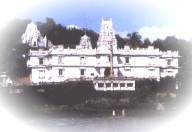
Murdeshwar Murdeshwar, 16 km from Bhatkal has recently shot into prominence as one of the loveliest spots in Karnataka. One can enter Murdeshwar from the Bhatkal-Honnavar National Highway through a specially erected big entrance decorated with intricate carvings. Murdeshwar symbolises the past glory of Hinduism. It is centered around the splendid Murdeshwar temple atop a hillock overlooking the Arabian Sea. Epic has it that this magnificent Murdeshwar linga emerged when Ravana threw the cloth covering the Atmalinga at Gokarn (another pilgrim centre in Uttara Kannada). And this cloth is presumed to have landed on this hillock called `Kanduka Parvata' and called Marideshwar'. The two inscriptions found in the older temple shed light on the construction of Nandi Mantapa in 1542 A.D. and the times of Devaraya II of Vijayanagar. There is however another version about the atmalinga being broken into four pieces & thrown by Ravana. The old temple has been recently renovated. Built in a Dravidian style, this temple excludes medieval grace and charm. The magnificent temple overlooks the Arabian sea. To the side of the compound wall is the Nataraja statue made of bell metal. A shrine of `Jattiga', the guarding deity, is seen installed outside the temple. One is greeted with the bewitching beauty of the surroundings as one reaches the top of the hillock. The vast stretches of silvery sands with the Sahyadri mountains framed into the background, the coconut trees dancing to the tunes of the billows, rose of boats dancing and drifting towards the shore, the sun looking like a ball of fire just before the sunset and then sinking into the sea - all weave a magic spell and make the viewers forget themselves.
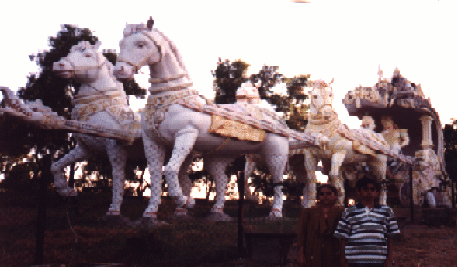
Netrani Island
Locally known as Netragudo, the Netrani island is an excellent picnic spot off the Bhatkal coast. Also called as Pigeon island, this Netrani island which is about 25 km from the Bhatkal coast, is a hill in the Arabian Sea.The island is enveloped by wild growth of trees and climbing the step hill is not that easy. If we are able to reach the top of the hill braving all hazards involved which is a rewarding experience we can see the idol of Jattiga and sculptures of cocks and elephants on one side and grave of a Muslim on the other. It is believed that it was once common to take vows to offer worship here. The ruins of a temple, a Roman catholic church and a mosque can still be seen. The island has sheltered innumerable wild goats.Manki
Located about 28 km from Bhatkal,Manki is a place of considerable antiquity and was a famous Jain centre during the 14th and 15th centuries. The place has temples dedicated to Ganapathi, Venkataramana, Durga etc. The place has 3 mosques.ADDITIONAL PLACES OF INTEREST
Shirali , Hadwalli, Kaikin , Marvanthe , Chitrapur , Shirali 4 km from Bhatkal on the National Highway is Shirali, a place of considerable antiquity. Lying on the north of the Venktapura river, Shirali has inscriptions of the Alupas, Hoysalas, Hadwalli rulers and Vijayanagar. This place houses a centre which measures rainfall. The Mahaganapathy temple is situated here. The idol of Ganapati is carved out of stone whereas the icon of Mahamaya is made of an alloy of five metals.
Hadwalli
Hadwalli which falls under Bhatkal taluk lies on the Sagar road about 20 km from Bhatkal. It had been once the capital of the Saluvas. Shorn of all its glory, it has since been reduced to an anonymous hamlet. The village amidst lush foliage has interesting Jain monuments. The Padmavati temple is one of its prized possessions. In this temple one can see an array of statues of 24 Theerthankaras engraved in fine black polished stone, each over a half meter tall. The beautiful bell metal statues of Yakshi, Padmavathi, Jain, Saraswati and Brahma on horseback bear testimony to the excellent of the artists of yore. Especially so the bell metal icon of Ananthana Theerthankara encircled with a halo on which are engraved the figures of 72 Threethankaras. Nearby there are two hillocks called Chandragiri and Indragiri. Below Chandragiri is the fine Chandranatha Basti of Vijayanagar times with fine lathe-turned pillars. In the smaller Basadi located outside this Basadi, we can see the transparent marble statue of Chandranatha in standing posture. The outer column contains engravings depicting pots, bracelets and anklets. The door with intricate carvings depicting creepers reveal a high standard of artistic excellence.Kaikini Prominent centre of ancient times, this village of about 6,000 people, is 13 km from Bhatkal and lies along the Bhatkal-Honnavar Road. The only basadi, is the old Parshwanatha Basadi, which houses 24 engravings. One of the inscriptions found in the Basadi testifies to the facts that Kaikini was a busy town in far-off days, that 24 `Jananis' look after the town administration and that during Vijayanagar period, it was a bee-hive of `Vaisya' (traders) activities.
Marvanthe A fairyland of scenic beauty, about 45 Kms from Bhatkal is Marvanthe, a scenic spot. The highway bordered on either side by the Arabian Sea and the Sauparnika River, with the Kutachadri Hills forming the background, makes the drive an exciting experience. And at sunset a crimson sky and golden rays reflected both in the sea and the river convert Marvanthe into a fairy land of scenic beauty.
Chitrapur
Shri Chitrapur Math, the renowned Parijnanashrama Swamiji's monastery, is the abode of six samadhis at Chitrapur (Shirli). So far a lineage of ten swamijis has been at the helm of affairs here starting with Swami Parijnanashram ascending the Peetha in 1675. The tenth swamiji in the lineage known as Parijnanashrama swamy the third who died recently was an acclaimed scientist. Around this monastery are situated the temples of Gopalkrishna, Dattatreya, Shantadurga and Keshvanarayana. A beautiful park has been raised in the vicinity of the Math and animals like the deer, hare, etc., have been reared. The Shri Chitrapur museum set up in 1973 houses a mass of archival wealth and several types of conches, halos made of bellmetals, plates, idols made up of ivory & sandalwood, swords, shields, spears, copperplates and a lamp dating back to the 13th century and many other artistic articlesH I S T O R Y
At a time when the whole community was writhing in the grip of ignorance, a few thinkers decided to awake the literally sleeping community by opening a maktab (elementary school) by the name "Islah-O-Tanzeem" in 1912. But the need to form a bigger institution cropped up and as a result the " Anjuman Hami-e-Muslimeen" was founded on 2nd Aug, 1919 to intiate the process of bringing education to the door-steps of the common man. Almost all had favoured the idea. It was initiated as a result of the painstaking efforts of illustrious men like F.A. Hasan, I.H.Siddique, M.M.Siddique , Haji Hasan, S.M. Syed Muhammed , Syed Abubaker Moulana, Abu Abdurrahman among others. F.A. Muhammed Hasan became its first president while M.M. Siddique its first school on Sept. 1, 1919, with only 11 students on its roll. Primary section was added in 1929, and the same year also saw the recognition of the school by the Government. Moving steadily and with the support from the community's elite, the school was upgraded into a high school in June 1939. Thus was born the Islamia Anglo Urdu High school at Bhatkal The very first batch of this high school comprised of 8 students only. And from here onwards Anjuman never looked back, but progressed with all its might. At present, 740 students are on the rolls with 41 staff in this Islamia Anglo Urdu High School. Mr. Usman Hasan Jubapu's tenure as the headmaster for 27 years is worth recalling. It was he who played a vital role in bringing quality to teaching. Mr. V.V. Nainan was the school's first head master. The school administration under Mr. U.H.L. Bhat is also worth recalling.
Anjuman Arts, Science & Commerce College
Established in 1968 and conceived by S.M. Haji Syed Mohiddin, this college initially started with only the arts faculty. Science course was introduced in 1969 & commerce in 1975. Prof. S. Nazeer Ahmed was its principal. In the first instance the college was accommodated in the high school building and was later shifted to the new location atop the hillock. The college with 1029 students including 294 girls and 60 staff is just one aspect of the Anjuman. This institution is affiliated to the Karnataka University, Dharwad. The college library has a good collection of books numbering 14,875 and it subscribes to over 50 periodicals. The college has a separate well-equipped laboratory block. Prof.Abdul Rahman is the present principal of this college.Anjuman Girls' High School
Started in June 1971 in `Farhat Manzil' at Sultan Street with Mrs.Rasheeda Basha as the Head Mistress (she still holds the post) this Anjuman girls' high school was conceived by Messrs. Usman Hasan and S.M. Yahya, then Anjuman's general secretary & now its president. English medium section was introduced in June 1979 and the school now located in the Basti Road has 527 students on its roll and 26 staff.Anjuman Nursery and Primary School
Attach to the Islamia Anglo High School Anjuman Primary and Nursery school was opened was in August 1973. It was only a primary school then and the nursery section was introduced in June 1981. The Nursery school has 190 students and 677 students are enrolled in the primary section with a total of 25 staff Anjuman Pre-University College For Women Accommodated in the girls high school, the Anjuman Pre-university college for women was started in July 1980. This college has only an arts faculty. The present strength is 86. The staff includes 3 full-timers and 4 part-timers.Anjuman Engineering College
Striving to reach greater height, this professional private un-aided engineering college was established inspite of stiff resistance from a number of people. This is located atop the same hillock where the Anjuman arts, science and commerce college is situated. This college started its innings in Aug 1980. Great efforts were put into the establishment of this professional college, which is the only one of its kind in the entire North Kanara District. Now, the college has five branches, viz., Civil, Mechanical, Electrical & Electronics, Electronics & Communication and Computer Science and Engineering. The college's present intake is 250. The college has gained wide recognition for quality engineering education attracting students from all over the country.THE CHRISTIAN COMMUNITY OF BHATKAL
The Christians of Bhatkal and its environs, namely, Mundalli, Purvarga and Karikal, would number about a thousand. Add to this a hundred or more of the students at the Anjuman Engineering College hailing from Kerala, Andhra Pradesh and Tamil Nadu. The students belong to a variety of Christian denominations, but the local Christians are all of the Roman Catholic fold and speak one language, Konkani. For congregational worship they gather at four centres: at the central church in Mundalli at the sub-churchin Purvarga, at the Anand Ashram Convent chapel, and at a small prayer hall in the new settlement at Karikal which is 4 kms, west of the bus station. Anand Ashram Convent School in Bhatkal needs no introduction today. But the origin of a school that caters to nearly 100 students is not so well known to all. The school began as a little teaching centre near the old bus stand. Two sisters came daily from Ternamakki and taught the rudiments to children and some older persons from 1972 until Sisters became resident there with the minimum of space for two or three classes. It was not until some years later that the sisters shifted the school to its present location. Sr. Barbara was the head mistress at that time. They started in 1973 in a rented building near the old bus stand. Sr. Syra, the present head-mistress of the school, was one of the four pioneers. Ever since their coming to Bhatkal the Christian community has enjoyed the benefit of their services in more ways than one. The school itself serves the educational needs of the general public. Education on all fronts is a crying need of Bhatkal Christians. However as in the rest of the Indian little towns and villages great value is not attached to formal education in this place. Not all teaching institutions are of high the community with the most limited opportunities in life. Most local Christian men have worked as stone masons and tailors within Bhatkal town. If a handful went to some mega cities within India, or once in a while to a gulf country, it was mostly as tailors or masons and labourers.In that capacity, then the Christian have rendered continued service to the richer section of the people of these parts. The trend is changing at snail-pace as a few more persons each year open their eyes to the importance of formal education and send their children. One wonders at times whether Christians of Bhatkal and Honnavar taluk were brought down from Goa as a work-force. Available evidence suggests that the rulers of the Bednur Kingdom did invite Christians from Goa, experienced farmers and artisans that they were, to come and develop farms and take other opportunities for work in the Kingdom. Although no more than half a dozen families live by cultivation today, it is acceptable that the dominant community of Bhatkal did at one time look up to them for farming. At any rate, the fact of Bednur rulers inviting them shows that Bhatkal Christians are not local converts but immigrants from Goa. There appear to have been two waves of exodus from Goa, each for a different reason, one in the 16th century, the second in the 18th. The present leadership, however is quietly working for the transformation not merely of Christians, but of all religionists. They hope to set up a centre in town for this purpose.